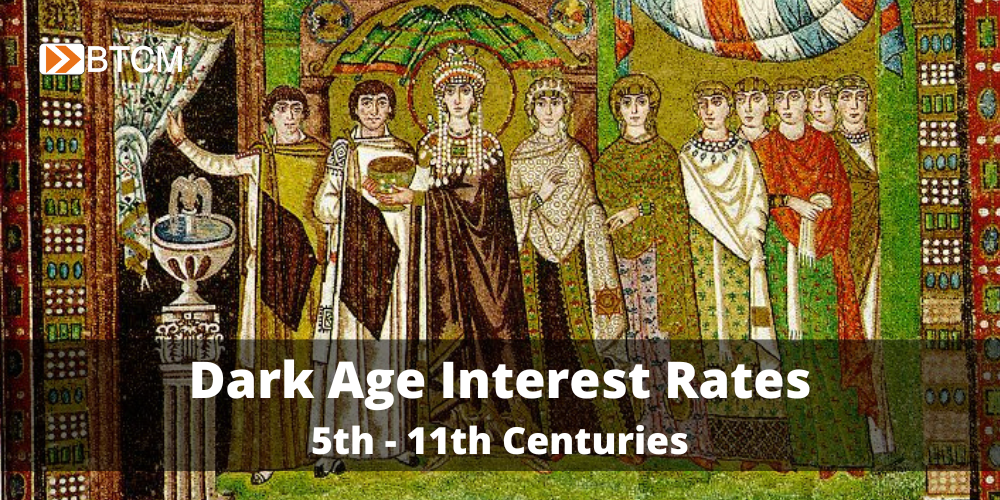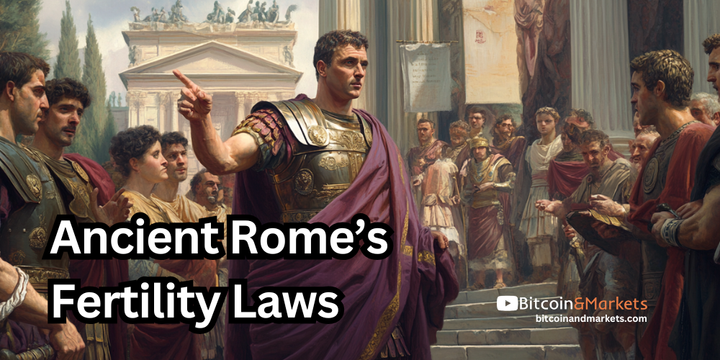Dark Ages Interest Rates: 5th - 11th Centuries

Author: Kent Polkinghorne
Source material: A History of Interest Rates, Fourth Edition by Sidney Homer and Richard Sylla (1963, 2005). This book covers interest rate history dating back to ancient times and contains very interesting charts, tables, and analysis which I will attempt to modernize and summarize. This data can expand our understanding of different eras of monetary and financial information to make us better investors.
Background
The Dark Ages, in stark contrast to the preceding period, were a time of political fragmentation. The power of cities was transferred to manors and individual estates, in other words, industrial societies became more agrarian in nature. Power itself weakened but became more distributed and localized. Nation states were generally small and/or weak and it appears that nobles often exercised equal or greater power than that of kings due to the localized nature of governance. Conforming to the new trend required an adaptation from reliance on the division of labor to reliance on self, essentially being solely responsible in providing for your own consumption. Due to the absence of records, there will be no chart in this week’s missive. We do know that credit existed, however, as evidenced by campaigns against usury by the church as well as the existence of civil ordinances either regulating usury or banning it altogether. Before jumping directly into our summary of money and credit during the Dark Ages, it is important to understand the intellectual framework that governed the rules and behaviors of people during this period.
Influences on Dark Age Thinking
The intellectual framework that governed the Dark Ages was spearheaded by a number of individuals who were closely aligned with the newly formed Roman Catholic church. The arguments put forward by these church leaders would have a lasting impact, not only in the area of money and credit, but on the whole of western European culture and thought. We will cover a few key arguments made by church leaders against usury here.
The Council of Nicea passed a canon prohibiting usury by clerics in the year 325 citing Psalm 15 in support for the prohibition. Verse 5 of Psalm 15 reads as follows:
He that putteth not out his money to usury, nor taketh reward against the innocent. He that doeth these things shall never be moved.
Essentially, those who refused to take usury were esteemed as being worthy of entrance into the kingdom of God.
During this time, it appears that usury was defined simply as “charging excessive interest” though it is unclear what would qualify as an excessive interest rate. A few decades later, St. Jerome (c. 342-347 – 30 September 420) argued that charging usury was prohibited, not only within the confines of the Christian brotherhood, but with respect to all people. This argument reversed the precedent which had been set earlier, in the book of Deuteronomy:
19 Thou shalt not lend upon usury to thy brother; usury of money, usury of victuals, usury of anything that is lent upon usury. 20 Unto a stranger thou mayest lend upon usury; but unto thy brother thou shalt not lend upon usury: that the Lord thy God may bless thee in all that thou settest thine hand to in the land whither thou goest to possess it.
Under the precedent set in Deuteronomy, Hebrews were forbidden from taking usury from other Hebrews. They could, however, take usury from non-Hebrews. St. Jerome went on to support his claim by citing the teachings of the prophets who followed Moses and also cited the New Testament itself. However, his manner of thinking was somewhat contrary to the argument put forward by his contemporary, St. Ambrose (c. 340 – 397), who himself argued that usury was legal against the enemies of God’s people, an idea which aligned itself moreso with the book of Deuteronomy. Lastly, Pope Leo I (c. 400 – 10 November 461) prohibited clerics from accepting usury while also heaping scorn on laymen who took usury although it appears that the practice was not banned for the latter.
The Roman Catholic thinkers of late antiquity had an immense impact on the thinking and behaviors of people, not only during the Dark Ages, but well after the Dark Ages had ended. Before introducing our history of Dark Age money and credit, it is important to cover usury laws as they existed during the Dark Ages themselves. This will help us understand the context within which money and credit functioned during this period of history.
Usury During the Dark Ages
Charlemagne (2 April 748 – 28 January 814), who was arguably the most powerful ruler during the Dark Ages, forbade the charging of usury. His law against usury was enshrined in the Capitularies of Charlemagne. The Capitularies also made one of the earliest efforts to define usury by defining it as a situation “where more is asked than is given.” The mere fact that a usury law had to be placed into effect at this time serves to indicate that credit was active, however, no interest rates from this time are provided. Keeping such records would have provided for easy evidence of guilt in a legal case and was thus too risky to do.
A few decades after Charlemagne came the Synod of Pavia (850) which excommunicated laymen who took usury. After the 9th century there does not appear to have been any additional information on the topic of usury until we reach the 11th century. At this juncture, usury was now considered a form of robbery and a sin against the 7th Commandment (thou shalt not steal).
Now that we are equipped with a firm understanding of how early middle age thinkers approached the topic of usury, we can now venture into the topic of money and credit themselves.
Background on Money and Credit
Despite the fall of the western half of the Roman Empire, Roman gold coins continued to circulate during the 5th and 6th centuries. Unfortunately, the record on money goes somewhat dark, pun intended, for the next few centuries. The Muslim Arab conquests of the Levant, North Africa, and Spain brought trade around the Mediterranean, and essentially all of southern Europe, to a halt in the 7th century. This event was followed by the Viking raids of the 8th century which had a similar effect on trade in northern Europe. These dual events appear to have also been catalysts toward the rise of serfdom. The institution of serfdom became commonplace in the 8th century and would continue to expand through the duration of the Dark Ages and beyond.

Trade in salt, metals, food, and wine continued during this time but it is unclear if any other goods, aside from metals, performed the role of money. Money was still used of course but the lack of commerce reduced its circulation. Toward the end of the 8th century, new small denomination silver coins were created by Charlamagne to supplant Roman gold coins. The coins he had minted consisted of a silver penny that was called the denier.
By the following century, due to economic and political weakness in Europe, nobles took for themselves the kings right to coin metals, however, circumstances began to turn for the better and by the 10th century Venetians began to secure financing for maritime ventures. Due to the Venetians increased need for financing, the importance of coiners and money changers grew out of necessity. Toward the end of the century, it is also reported that Arab countries were purchasing slaves, metal goods, timber, and other goods from Europe while using gold as their medium of exchange.

Political and economic stability was mostly restored by the 11th century and gold coins from the Byzantine and Arab kingdoms began to circulate more widely in Europe but the problem of currency debasement remained widespread. It is the authors opinion that, despite the increased circulation of Byzantine and Arab coins, demand for metallic money was far higher than what the Byzantines and Arabs could supply and this fact explains the rampant debasement. Thankfully, silver mining in Hungary and Saxony was quickly advancing as well during this time and would begin to fill the monetary void that had persisted over the preceding centuries.

It appears the main lender for the majority of the Dark Age period was indeed the Roman Catholic church. Church loans were secured by a land gage. The land gage was the ancestor to the more familiar mortgage we know today. Land gages appeared in two forms: the live gage and the dead gage. A live gage was when the revenue generated by the secured land (collateral) paid for the loan principal. A dead gage (mortgage) was when revenue generated by the secured land did not go toward principal but was instead used to pay interest which made it a form of usury and drew upon it the ire of the church.
It was during the 11th century that commercial credit began to evolve into the forms that would be better recorded in the 12th century. The increase in commerce and productivity effectively ended the period we know as the Dark Ages and lead Europe into the Renaissance of the 12th century, a century fondly remembered for the development of Gothic architecture, and the century we will be covering next week.




